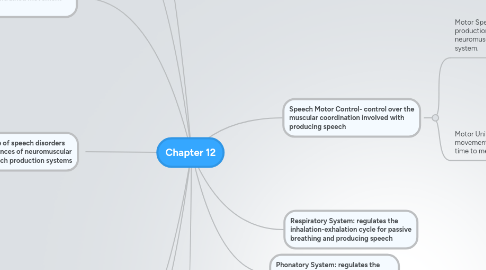Chapter 12
by Taylor Anderson


1. Resonatory System:regulates the resonation of the airflow as it moves from the pharnyx into the oral or nasal cavities
1.1. velopharyngeal port: opening between the velum and the back of the pharynx wall
2. Articulatory System: regulates the control of the articulators within the oral cavity to manipulate the outgoing airflow in different ways
3. Apraxia of Speech: an impairment of motor programming and planning that unvoloves an inability to transform a linguistic representation into the appropriate coordinated movements of th articulators
4. Dysarthria: a group of speech disorders caused by disturbances of neuromuscular control of the speech production systems
4.1. Muscle Tone: refers to the resistance to passive movement and reflects sustained muscle activity that provides postural support for the active. The tone may be reduced, or become flaccid
4.2. Muscle Strength: refers to the ability of the muscles to a desired level. May become flaccid
4.3. Movement Steadiness: the ablitiy of muscles to generate steady movements and may be distrupted by involuntary movements. Tremor and Hyperkinesis
4.4. Movement Speed: important for speech production, involves many rapid articulator movements, may be reduced or increased
4.5. Movement Range: how far a structure (tongue or jaw) can move, may be reduced
4.6. Movement Coordination: the ability to precisely ime muscle contraction so that each articulator moves the intended distance and direction at exactly the right time
5. Generalization: application or transfer of a skill to related but untrained movement patterns
5.1. Treatment Strategies: improve impaired systems and teach compensatory strategies
6. Conditions of Practice
6.1. Practice Variablity: number of different targets
6.2. Practice Schedule; the order in which the targets are practiced
6.3. Practice Amount: number of practice trials
6.4. Practice Distribution: how close in time the practice sessions are spaced
7. Feedback Conditions
7.1. Feedback Frequency: how often the learner receives feedback
7.2. Feedback Timing: how soon after an attempt the learner receives feedback
8. Speech Motor Control- control over the muscular coordination involved with producing speech
8.1. Motor Speech Disorder- impairment of speech production caused by defects of hte neuromuscular system or the motor control system.
8.2. Motor Unit/Motor Program: relatively invariant movement pattern that can be scaled in size and time to meet the demands of the particular situation
8.2.1. Motor Planning: the pocess that define and sequence articulatory goals
8.2.2. Motor Programming: the processes responsible for establishing and preparing the flow of motor information across muscles for speech production and specifying the timing and force required for the movements
8.2.3. Motor Execution: the process responsible for activating relevant muscles during the movements used in speech production
8.2.4. Motor Learning: the way in which practice or experience leads to relatively permenant changes in the capability for movement
8.2.4.1. Schemas: memory representations of relationships between various sources of information
